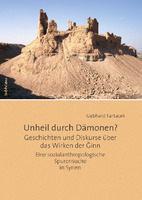Unheil durch Dämonen?
Geschichten und Diskurse über das Wirken der Ginn. Eine sozialanthropologische Spurensuche in Syrien
Author(s)
Fartacek, Gebhard
Collection
Austrian Science Fund (FWF)Language
GermanAbstract
Narratives about people haunted by demons have a long tradition in the Middle East. The Koran
addresses the existence of demons, although their overall significance in it is limited. In contrast,
dangerous demons and accompanying phenomena, such as the evil eye and witchcraft, play a vital role
in concepts of folk religion. Particularly in peripheral and rural areas of the present-day Syrian Arab
Republic, many people have stories to tell about their own encounters with such supernatural beings.
In my research, I have collected such narratives, orally transmitted over time, and I have reconstructed
subsequent discourses. More specifically, I have pursued the two following questions: In which spatial
and temporal spheres do demons appear? And: Which human behaviours are likely to cause dangerous
demons to appear?
My analysis firstly replicated and extended structural approaches which presume demons and other
metaphysical entities in spatial and temporal border zones.
Secondly, evidence was collected to demonstrate that demons appear primarily when humans are faced
with uncertainties - regarding ethical-moral decisions, regarding the realm of sexuality, or the
construction of individual and collective identities.
Narratives about encounters with demons inevitably lead to discourses about important issues of great
urgency. In theory they can be described as conflict-laden topics regarding ethics and morals, sexuality,
social change, and identity. However, the topics of these discourses are not abstract theories claiming
universal validity. Quite the contrary: On the basis of concrete events in concrete contexts, concrete
options for a virtuous and good life are discussed.
These concretizations, in the narratives as well as in the discourses, form an effective strategy in
creating security in a world full of uncertainties. The folk religious concepts regarding the demons’
influence therefore provide an opportunity to cope with negative experiences of contingency.
Moreover, particular relevance of the local-cultural beliefs in demons lies in dealing with value
conflicts. Focusing on situations of daily life, such local-cultural concepts appear to be valid even when
contrasted with other, concurring models of reality. Viewed in this light, they are essential, practical,
and useful for the people in the Syrian periphery - at least today, and perhaps also tomorrow. Erzählungen darüber, dass der eine oder andere bereits von Dämonen heimgesucht wurde, besitzen im
Nahen Osten eine lange Tradition. Im Koran wird die Existenz von Dämonen zwar angesprochen, doch
ist deren Stellenwert dort insgesamt nicht allzu groß. In den volksreligiösen Konzeptionen hingegen
spielen gefährliche Dämonen und damit einhergehende Phänomene wie Böser Blick und Zauberei eine
sehr wichtige Rolle. Vor allem in den peripheren und dörflich geprägten Gebieten der heutigen
Arabischen Republik Syrien wissen zahlreiche Menschen von ihren eigenen Erlebnissen mit solchen
Geistwesen zu erzählen.
In meiner Forschungsarbeit habe ich solche oral tradierten Geschichten gesammelt und die daran
anschließenden Diskurse rekonstruiert. Konkret bin ich zunächst folgenden beiden Fragestellungen
nachgegangen: In welchen räumlichen und zeitlichen Zonen treten Dämonen in Erscheinung? Und:
Welche menschlichen Verhaltensweisen sind es, die das Erscheinen gefährlicher Dämonen
wahrscheinlich machen?
In meiner Untersuchung konnten erstens jene strukturalen Ansätze repliziert und weiterentwickelt
werden, die Dämonen und andere metaphysische Entitäten in räumlichen und zeitlichen Grenzzonen
vermuten.
Zweitens konnten Belege dafür gesammelt werden, dass Dämonen primär dann in Erscheinung treten,
wenn Menschen mit Ungewissheiten konfrontiert sind, - dort wo es um ethisch-moralische
Entscheidungen geht, dort wo es um den Bereich der Sexualität geht oder um die Konstruktion
individueller und kollektiver Identitäten.
Die Erzählungen über Begegnungen mit Dämonen münden zwangsläufig in Diskurse über Fragen, die
den Menschen unter den Nägeln brennen. Theoretisch sind sie mit den konfliktträchtigen Themen über
Ethik und Moral, Sexualität, sozialer Wandel und Identität, zu umschreiben. Themen dieser Diskurse
sind jedoch nicht abstrakte Theorien mit universellem Anspruch. Ganz im Gegenteil: Anhand konkreter
Begebenheiten in konkreten Kontexten werden konkrete Möglichkeiten des richtigen und guten Lebens
erörtert.
Diese Konkretisierungen – sowohl in den Geschichten als auch in den Diskursen – bilden eine
wirksame Strategie, Gewissheit in einer Welt voller Ungewissheit zu erzeugen. Die volksreligiösen
Konzeptionen über das Wirken der Dämonen sind damit eine Möglichkeit, negativ erlebte Kontingenz
zu bewältigen.
Darüber hinaus liegt eine besondere Relevanz des lokalkulturellen Dämonen-Glaubens in der
Bearbeitung von Wertkonflikten. In ihrer Bezogenheit auf das Alltagsgeschehen scheinen diese
lokalkulturellen Konzeptionen auch in der Konfrontation mit anderen, konkurrierenden,
Wirklichkeitsmodellen Bestand zu haben. So gesehen sind sie für die Menschen in der syrischen
Peripherie zumindest heute – und vielleicht auch morgen – notwendig, brauchbar und lebensdienlich.
Keywords
Social Anthropology; Islam; Djinn; Ethnography; Syria; Evil Eye; Böser Blick; Sozialanthropologie; SyrienDOI
10.26530/oapen_437183ISBN
9783205784852OCN
995257523Publisher
BrillPublisher website
https://brill.com/Publication date and place
2010Grantor
Imprint
BöhlauClassification
History


 Download
Download